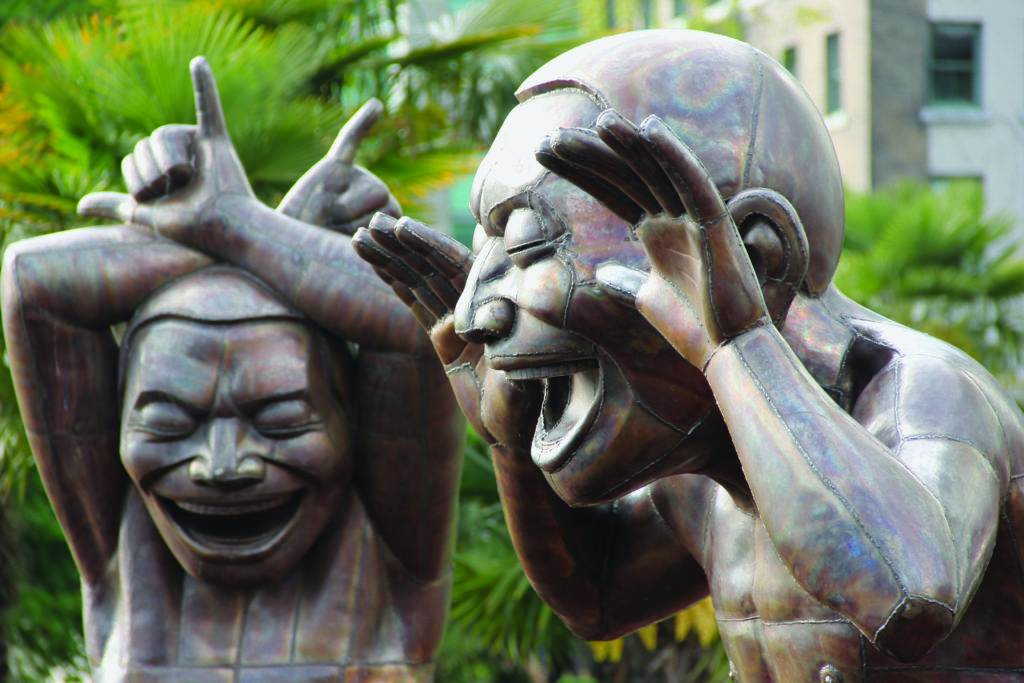It’s No Joke
BY MONNET ZUBIETA
What is this precious love and laughter budding in our hearts? It is the sound of a soul waking up.
—Hafiz
There are so many styles and approaches to yoga these days. Some are more heart-centered and others pay more attention to physical alignment. Some are done in quiet candlelit rooms, while others are done to the beat of live music. Have you ever thought about what unites these practices? Are you like many in the yoga community who think Laughter Yoga isn’t really yoga—it’s a joke? Maybe after reading this you will realize that, not only are there a myriad of therapeutic benefits, but it really is yoga.
Laughter Yoga was born 20 years ago when Dr. Madan Kataria gathered five people at a park in Mumbai, India, to laugh for no reason. The idea was inspired while he was writing an article called “Laughter Is the Best Medicine.” Because of the compelling research, he wanted to prescribe 20 minutes of sustained, hearty laughter to his patients. Now there are thousands of people doing Laughter Yoga all around the globe.
Many yoga classes in the US are filled with lululemon-clad yogis doing asanas. The Patanjali Yoga Sutras, one of the authoritative texts on yoga, says that asana is just one of the eight limbs of yoga. A Laughter Yoga session usually begins with stretching and breathing (asana and pranayama). Participants are invited to reach up to the sky (Urdhva hastasana) and then fold forward (Uttanasana) with a sense of childlike playfulness, exhaling with a prolonged laugh until the lungs are empty. Kids don’t need a reason to laugh. That is why they laugh so much more than adults. With Laughter Yoga you don’t have to be in a good mood to laugh—just come with the intention to laugh. Studies show that your brain doesn’t know the difference between what you are really doing and what you are thinking about.
Laughter exercises are used to simulate and stimulate laughter. To simulate laughter we do playful activities with a smile that sound like laughter, such as Cranking Up Your Laughter Engine. Cellphone Laughter and Long-Lost Friend Laughter are examples of stimulating laughs. Just think about cracking up while talking to the funniest person you know on your cellphone. Or imagine ecstatically running across the room and embracing a stranger with glee as if they were your longlost friend. Because laughter is contagious, fake laughs quickly turn into genuine, spontaneous laughter.

After the giggles get going during the laughter exercises, Laughter Meditation is the time to lay your laughter down. Participants lie in a circle with heads together—hearing each person stimulates nonstop cathartic laughter. Then it is time for relaxation, so your body can integrate the benefits of the laughter practice. The mission of Laughter Yoga is world peace, health, and harmony through laughter, so sending joy to the world is the final touch.
Yogas Chitta vritti nirodaha is a phrase from the Yoga Sutras often mentioned in yoga classes. The phrase essentially means that yoga is the restraint of mental formations, which include our thoughts, memories, beliefs, worries, and so on. In Laughter Yoga there are several exercises designed to stop the vrittis (mental formations). With Jackhammer Laughter we joyfully blast away things in our life that are stuck or solid. The Tug-o’-War exercise allows us to laugh at situations in our lives that we are struggling with. It is the mind that makes us believe we are individuals. When the mind is quiet, the false feeling that we are separate is dissolved. The tranquility, delight, and connectedness that participants feel at the end of a laughter session reveals that laughing heartily and playfully for half an hour or more is an effective way to clear the mind.
Each of the 18 chapters in the Bhagavad Gita is a type of yoga. Krishna tells Arjuna in the 12th chapter that a yogi should have the following three qualities.
- Control over the senses. Everything is associated with our senses—our likes and dislikes, anger and lust. Anger comes when we are prevented from enjoying something we want. Practicing Mask Laughter helps us remember that our emotions are like a mask that we can put on and just as easily take off to reveal the eternal bliss, which is our true nature.
- Equanimity in all circumstances. Whatever the situation—happy or sad, praise or blame—the one who can keep calm is considered a yogi. Appreciation and Naughty-Naughty Laughter are fun exercises that remind us not to be swayed by what others think. Triggers from aversion to criticism are faced with laughter, healing past traumas.
- Having the welfare of all beings in one’s heart. In every heart of every living being resides a spark of the divine. When we see others in such a way, the desire to help and do good deeds is natural. Laughter Yoga leaves people feeling connected, openhearted, and compassionate.
If the goal of yoga is to uncover our true identity, which is eternal bliss consciousness, then Laughter Yoga is a potent path to meet that end. And Laughter Yoga is offered in the spirit of generosity all around the world. It is fun, therapeutic, and free!
Monnet Zubieta, RYT, is a Laughter Yoga teacher, Master Laughter Trainer, and hatha yoga teacher. MoreJoy.org